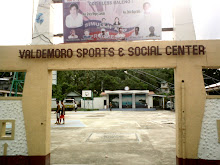Dewey’s victory of the battle of Manila bay ushered in an era of political transformation, particularly in the town of Baleno. In 1901, after the general elections, Florentino Vidal was elected president. Meanwhile, Aroroy was developing due to her mines, forests, and fisheries. Its natural advantages, lying between to old town, San Agustin and Baleno, with good harbor, made it a better site for new town. In 1903 therefore, to effect economy on the part of the government, Baleno and San Agustin were fused together to form the Municipality of Aroroy. In the general elections of 1903, Matias Inopia, a native of Baleno is elected first president of Aroroy. Francisco Valdemoro Sr., Elpidio Cortes and Isidoro Albao, all son’s of Baleno, occupied for some time the presidential chair of Aroroy, Baleno remained a barrio of Aroroy until 1949, when it was created a separate Municipality.
While Baleno had degenerated politically, some of her sons had won unequalled fame. That man, Pedro Chavez, who was for some time the parish priest of Baleno, tempted by the lure of politics and inspired by his ardent patriotism, renounced his vows, discarded his habiliments and entered into the political arena. He decided to reside permanently in Baleno. Cognizant of the will of his constituents, that was his, made him candidate for representative of the Philippines national assembly. Masbate was a sub-province then of Sorsogon. He was elected and became representative of Sorsogon to the first Philippine National Assembly, and rose to an unprecedented height. He introduce the first Philippine independence bill which became the forerunner of succeeding independence bills.
Another political luminary of Baleno was Gonzalo Licup. He was once the municipal Treasurer of Aroroy and Milagros. In 1916, he was appointed lieutenant governor of the sub-province of Masbate by governor general Francis Burton Harrison. When Masbate became a separate province, he was elected a member of the provincial board.
Alongside with the changes in the government was the progress in education. In 1905, Mr. Moore, a Thomasite, organized the first public school in this town. At its inception, very few pupils, mainly adults attended it. Some of the first pupils who finish the primary curse, were appointed teachers, after a short training at Masbate, the capital. Later on, the enrolment in the public school gradually soared higher. In 1921, under the gabaldon act, a permanent, two room building was constructed. In 1932, a four room semi permanent building and a modern home economics building were built to accommodate the growing school population.

The church has also contributed something to the educational progress of the people of Baleno. Church schools, (Cartilla or Catecheses) have been put up from time to time, to facilitate the teaching of the Roman Catholic religion to the youngsters. Partly due to this and to home training, Catholicism has so permeated the minds of the Children that even up to this time; we find the greater majority of the people to be devout Catholics. Several attempts to establish a protestant sect in Baleno failed miserable and only served to strengthen the hold of Catholicism.
During the incumbency of Fr. Francisco Banawa, as parish priest of Baleno, sometime in 1928, a religious re-awakening flared up. Under his leadership, many people were drawn closer to the church. He encouraged young boys to study priesthood. Consequently, some boys were won over to his career. However, only the Virtucio Brothers were ordained priests, Fr, Artemio Virtucio in 1940, and Fr. Antonio Virtucio, in 1950.
This political and socio-cultural progress would have been retarded were it not for the advancement in agriculture in Baleno. With the coming of the Americans, better means of farming were introduced and as a result, a new impetus in agriculture evolved. Moreover, steady market for Philippine products was found. All these favorable factors gave the Baleno people encouragement to devote to farming, eventually; Baleno became one of the most progressive coconut and abaca regions in Masbate. Opportunists in agriculture rapidly grew up to be coconut and abaca magnates and amassed wealth. On the whole, many landed people became prosperous.
Consequently to the increase in production business became so brisk and its volume so great that some commercial houses dealing in copra, hemp, and rattan were established. Most of this establishments were own by the Chinese. However, four Filipino businessmen, Teodoro Virtucio, Francisco Valdemoro, Felipe Valdemoro and Gonzalo Licup were prominent in this business. Retail businesses were controlled mainly by the Chinese.
The sixth year of the commonwealth of the Philippines was for Baleno a year of affluence and contentment. There were bounteous harvests of varied crops, a big circulation of money as a result of gold boom, easy and profitable employment everywhere in the Municipality of Aroroy, a low cost of living all tending to the attainment of an easy and contented living.

No comments:
Post a Comment